Deepwater Horizon Project Study: Risk Management and Organizational Maturity
VerifiedAdded on 2023/06/11
|8
|2611
|405
AI Summary
This report explores the case of Deepwater Horizon project in detail exploring the company as well as the project to identify how risks had occurred and how they should have been managed. It covers topics such as risk management, organizational structures, forms, and culture, engineering risk management, portfolio alignment & business value, portfolio management process cycle, and organizational maturity.
Contribute Materials
Your contribution can guide someone’s learning journey. Share your
documents today.
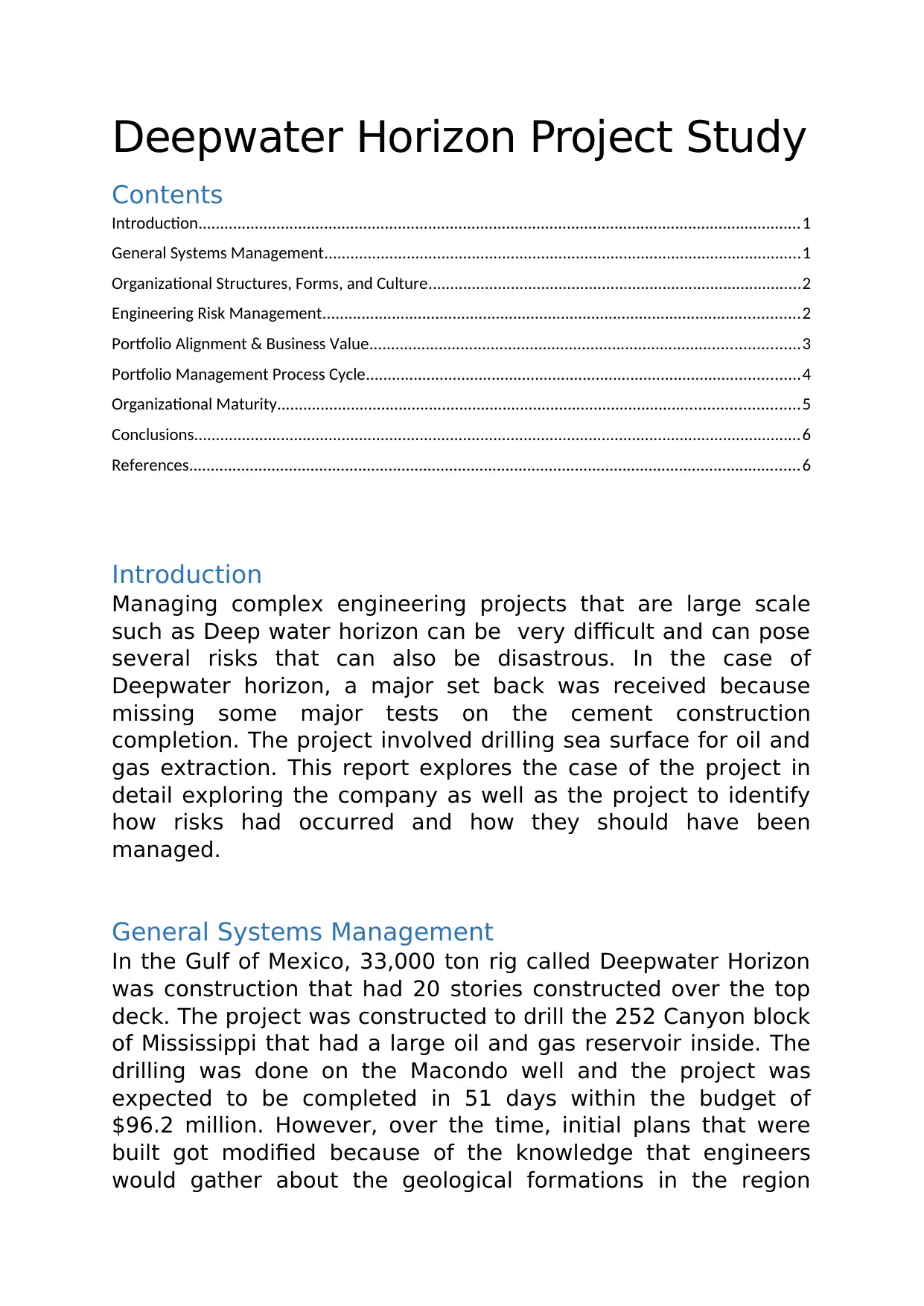
Deepwater Horizon Project Study
Contents
Introduction...........................................................................................................................................1
General Systems Management..............................................................................................................1
Organizational Structures, Forms, and Culture......................................................................................2
Engineering Risk Management..............................................................................................................2
Portfolio Alignment & Business Value...................................................................................................3
Portfolio Management Process Cycle....................................................................................................4
Organizational Maturity........................................................................................................................5
Conclusions............................................................................................................................................6
References.............................................................................................................................................6
Introduction
Managing complex engineering projects that are large scale
such as Deep water horizon can be very difficult and can pose
several risks that can also be disastrous. In the case of
Deepwater horizon, a major set back was received because
missing some major tests on the cement construction
completion. The project involved drilling sea surface for oil and
gas extraction. This report explores the case of the project in
detail exploring the company as well as the project to identify
how risks had occurred and how they should have been
managed.
General Systems Management
In the Gulf of Mexico, 33,000 ton rig called Deepwater Horizon
was construction that had 20 stories constructed over the top
deck. The project was constructed to drill the 252 Canyon block
of Mississippi that had a large oil and gas reservoir inside. The
drilling was done on the Macondo well and the project was
expected to be completed in 51 days within the budget of
$96.2 million. However, over the time, initial plans that were
built got modified because of the knowledge that engineers
would gather about the geological formations in the region
Contents
Introduction...........................................................................................................................................1
General Systems Management..............................................................................................................1
Organizational Structures, Forms, and Culture......................................................................................2
Engineering Risk Management..............................................................................................................2
Portfolio Alignment & Business Value...................................................................................................3
Portfolio Management Process Cycle....................................................................................................4
Organizational Maturity........................................................................................................................5
Conclusions............................................................................................................................................6
References.............................................................................................................................................6
Introduction
Managing complex engineering projects that are large scale
such as Deep water horizon can be very difficult and can pose
several risks that can also be disastrous. In the case of
Deepwater horizon, a major set back was received because
missing some major tests on the cement construction
completion. The project involved drilling sea surface for oil and
gas extraction. This report explores the case of the project in
detail exploring the company as well as the project to identify
how risks had occurred and how they should have been
managed.
General Systems Management
In the Gulf of Mexico, 33,000 ton rig called Deepwater Horizon
was construction that had 20 stories constructed over the top
deck. The project was constructed to drill the 252 Canyon block
of Mississippi that had a large oil and gas reservoir inside. The
drilling was done on the Macondo well and the project was
expected to be completed in 51 days within the budget of
$96.2 million. However, over the time, initial plans that were
built got modified because of the knowledge that engineers
would gather about the geological formations in the region
Secure Best Marks with AI Grader
Need help grading? Try our AI Grader for instant feedback on your assignments.
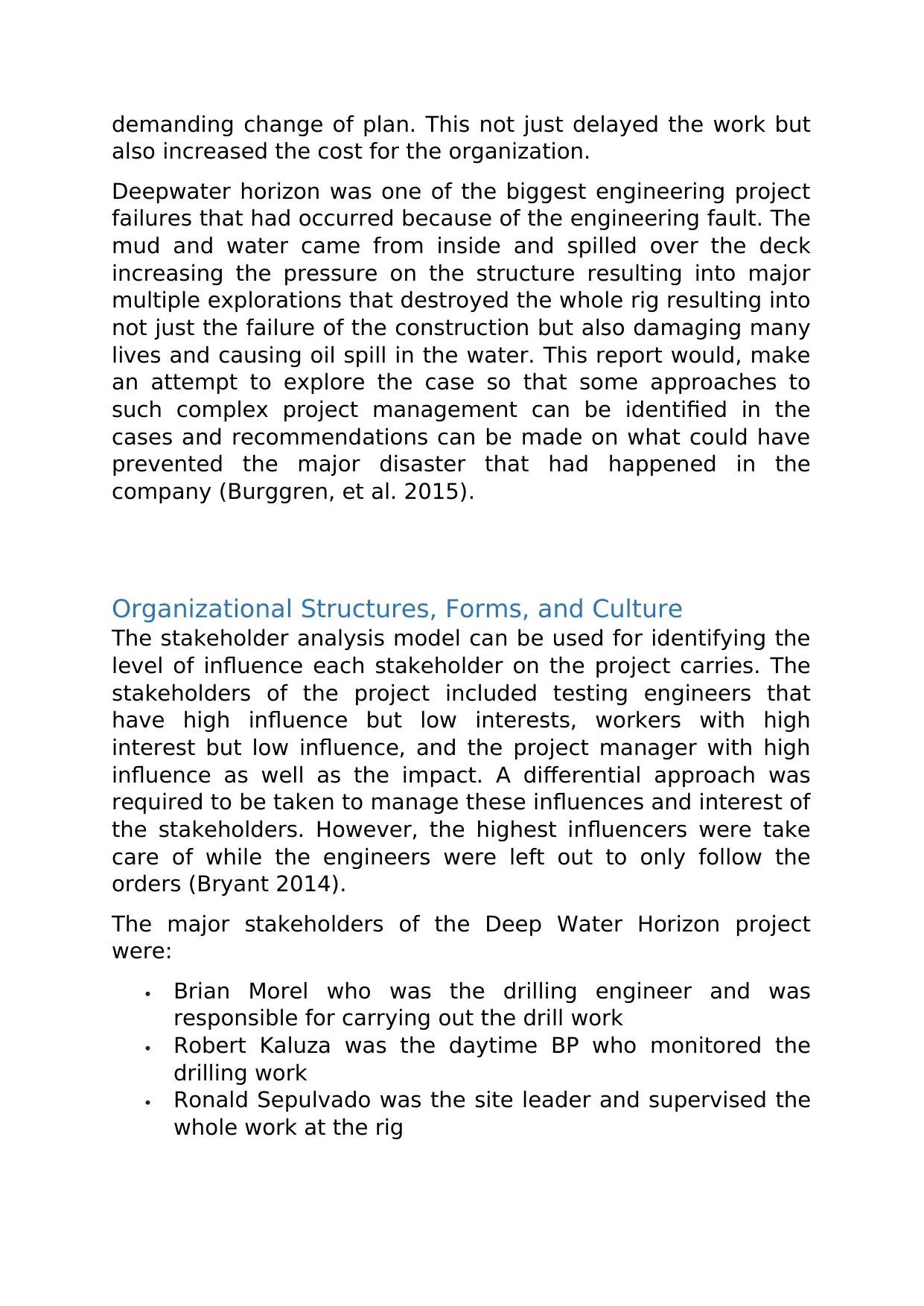
demanding change of plan. This not just delayed the work but
also increased the cost for the organization.
Deepwater horizon was one of the biggest engineering project
failures that had occurred because of the engineering fault. The
mud and water came from inside and spilled over the deck
increasing the pressure on the structure resulting into major
multiple explorations that destroyed the whole rig resulting into
not just the failure of the construction but also damaging many
lives and causing oil spill in the water. This report would, make
an attempt to explore the case so that some approaches to
such complex project management can be identified in the
cases and recommendations can be made on what could have
prevented the major disaster that had happened in the
company (Burggren, et al. 2015).
Organizational Structures, Forms, and Culture
The stakeholder analysis model can be used for identifying the
level of influence each stakeholder on the project carries. The
stakeholders of the project included testing engineers that
have high influence but low interests, workers with high
interest but low influence, and the project manager with high
influence as well as the impact. A differential approach was
required to be taken to manage these influences and interest of
the stakeholders. However, the highest influencers were take
care of while the engineers were left out to only follow the
orders (Bryant 2014).
The major stakeholders of the Deep Water Horizon project
were:
Brian Morel who was the drilling engineer and was
responsible for carrying out the drill work
Robert Kaluza was the daytime BP who monitored the
drilling work
Ronald Sepulvado was the site leader and supervised the
whole work at the rig
also increased the cost for the organization.
Deepwater horizon was one of the biggest engineering project
failures that had occurred because of the engineering fault. The
mud and water came from inside and spilled over the deck
increasing the pressure on the structure resulting into major
multiple explorations that destroyed the whole rig resulting into
not just the failure of the construction but also damaging many
lives and causing oil spill in the water. This report would, make
an attempt to explore the case so that some approaches to
such complex project management can be identified in the
cases and recommendations can be made on what could have
prevented the major disaster that had happened in the
company (Burggren, et al. 2015).
Organizational Structures, Forms, and Culture
The stakeholder analysis model can be used for identifying the
level of influence each stakeholder on the project carries. The
stakeholders of the project included testing engineers that
have high influence but low interests, workers with high
interest but low influence, and the project manager with high
influence as well as the impact. A differential approach was
required to be taken to manage these influences and interest of
the stakeholders. However, the highest influencers were take
care of while the engineers were left out to only follow the
orders (Bryant 2014).
The major stakeholders of the Deep Water Horizon project
were:
Brian Morel who was the drilling engineer and was
responsible for carrying out the drill work
Robert Kaluza was the daytime BP who monitored the
drilling work
Ronald Sepulvado was the site leader and supervised the
whole work at the rig
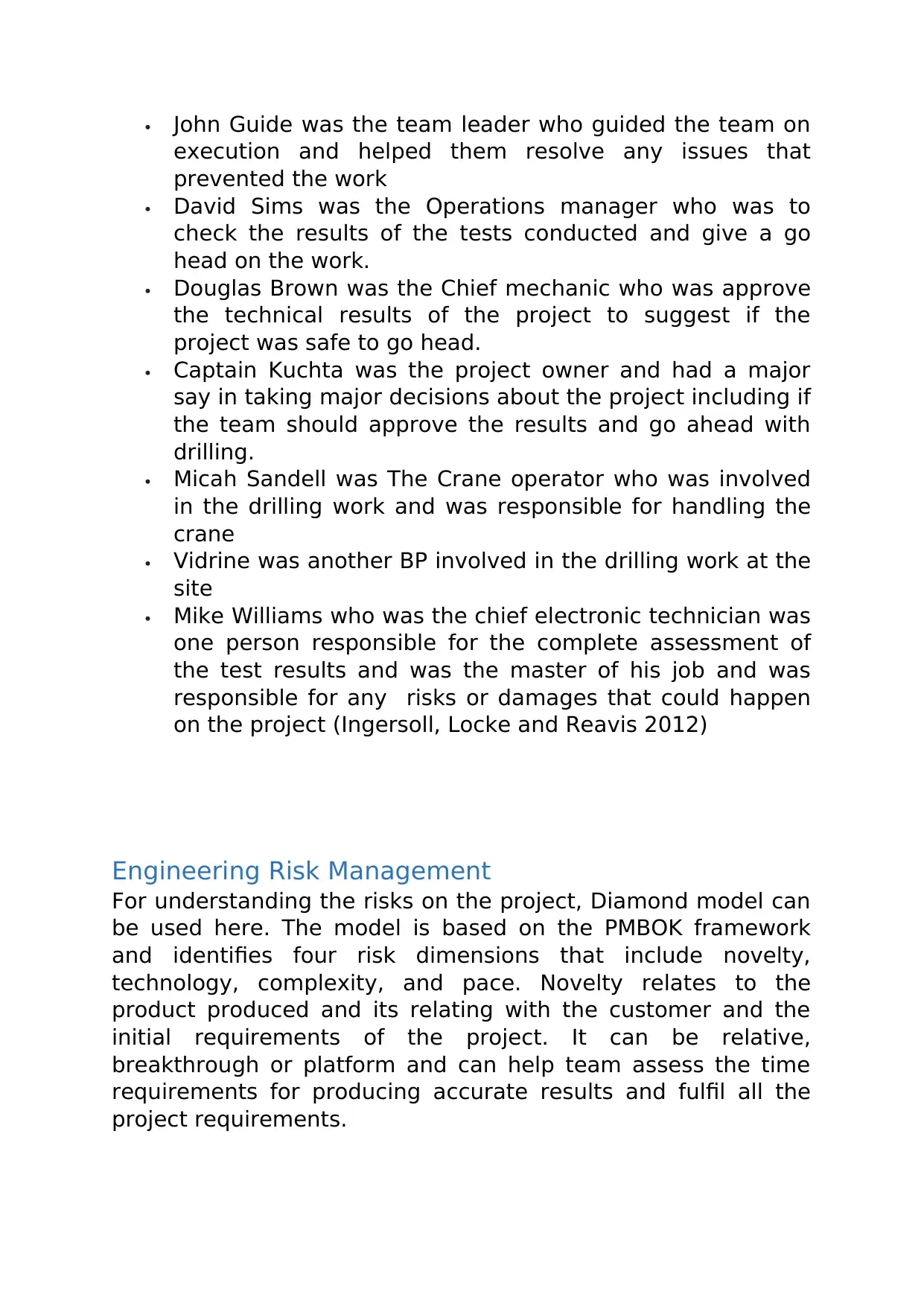
John Guide was the team leader who guided the team on
execution and helped them resolve any issues that
prevented the work
David Sims was the Operations manager who was to
check the results of the tests conducted and give a go
head on the work.
Douglas Brown was the Chief mechanic who was approve
the technical results of the project to suggest if the
project was safe to go head.
Captain Kuchta was the project owner and had a major
say in taking major decisions about the project including if
the team should approve the results and go ahead with
drilling.
Micah Sandell was The Crane operator who was involved
in the drilling work and was responsible for handling the
crane
Vidrine was another BP involved in the drilling work at the
site
Mike Williams who was the chief electronic technician was
one person responsible for the complete assessment of
the test results and was the master of his job and was
responsible for any risks or damages that could happen
on the project (Ingersoll, Locke and Reavis 2012)
Engineering Risk Management
For understanding the risks on the project, Diamond model can
be used here. The model is based on the PMBOK framework
and identifies four risk dimensions that include novelty,
technology, complexity, and pace. Novelty relates to the
product produced and its relating with the customer and the
initial requirements of the project. It can be relative,
breakthrough or platform and can help team assess the time
requirements for producing accurate results and fulfil all the
project requirements.
execution and helped them resolve any issues that
prevented the work
David Sims was the Operations manager who was to
check the results of the tests conducted and give a go
head on the work.
Douglas Brown was the Chief mechanic who was approve
the technical results of the project to suggest if the
project was safe to go head.
Captain Kuchta was the project owner and had a major
say in taking major decisions about the project including if
the team should approve the results and go ahead with
drilling.
Micah Sandell was The Crane operator who was involved
in the drilling work and was responsible for handling the
crane
Vidrine was another BP involved in the drilling work at the
site
Mike Williams who was the chief electronic technician was
one person responsible for the complete assessment of
the test results and was the master of his job and was
responsible for any risks or damages that could happen
on the project (Ingersoll, Locke and Reavis 2012)
Engineering Risk Management
For understanding the risks on the project, Diamond model can
be used here. The model is based on the PMBOK framework
and identifies four risk dimensions that include novelty,
technology, complexity, and pace. Novelty relates to the
product produced and its relating with the customer and the
initial requirements of the project. It can be relative,
breakthrough or platform and can help team assess the time
requirements for producing accurate results and fulfil all the
project requirements.
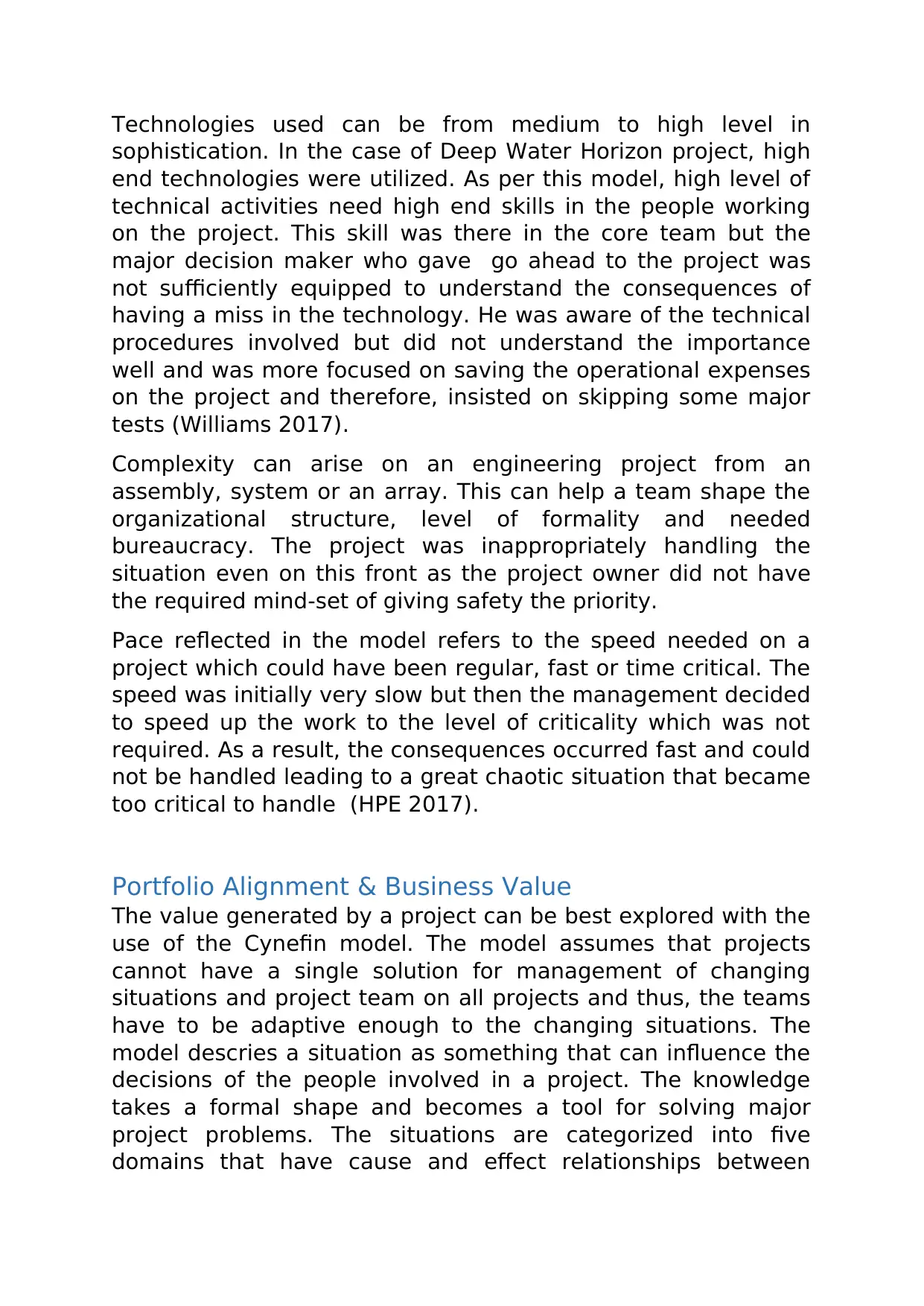
Technologies used can be from medium to high level in
sophistication. In the case of Deep Water Horizon project, high
end technologies were utilized. As per this model, high level of
technical activities need high end skills in the people working
on the project. This skill was there in the core team but the
major decision maker who gave go ahead to the project was
not sufficiently equipped to understand the consequences of
having a miss in the technology. He was aware of the technical
procedures involved but did not understand the importance
well and was more focused on saving the operational expenses
on the project and therefore, insisted on skipping some major
tests (Williams 2017).
Complexity can arise on an engineering project from an
assembly, system or an array. This can help a team shape the
organizational structure, level of formality and needed
bureaucracy. The project was inappropriately handling the
situation even on this front as the project owner did not have
the required mind-set of giving safety the priority.
Pace reflected in the model refers to the speed needed on a
project which could have been regular, fast or time critical. The
speed was initially very slow but then the management decided
to speed up the work to the level of criticality which was not
required. As a result, the consequences occurred fast and could
not be handled leading to a great chaotic situation that became
too critical to handle (HPE 2017).
Portfolio Alignment & Business Value
The value generated by a project can be best explored with the
use of the Cynefin model. The model assumes that projects
cannot have a single solution for management of changing
situations and project team on all projects and thus, the teams
have to be adaptive enough to the changing situations. The
model descries a situation as something that can influence the
decisions of the people involved in a project. The knowledge
takes a formal shape and becomes a tool for solving major
project problems. The situations are categorized into five
domains that have cause and effect relationships between
sophistication. In the case of Deep Water Horizon project, high
end technologies were utilized. As per this model, high level of
technical activities need high end skills in the people working
on the project. This skill was there in the core team but the
major decision maker who gave go ahead to the project was
not sufficiently equipped to understand the consequences of
having a miss in the technology. He was aware of the technical
procedures involved but did not understand the importance
well and was more focused on saving the operational expenses
on the project and therefore, insisted on skipping some major
tests (Williams 2017).
Complexity can arise on an engineering project from an
assembly, system or an array. This can help a team shape the
organizational structure, level of formality and needed
bureaucracy. The project was inappropriately handling the
situation even on this front as the project owner did not have
the required mind-set of giving safety the priority.
Pace reflected in the model refers to the speed needed on a
project which could have been regular, fast or time critical. The
speed was initially very slow but then the management decided
to speed up the work to the level of criticality which was not
required. As a result, the consequences occurred fast and could
not be handled leading to a great chaotic situation that became
too critical to handle (HPE 2017).
Portfolio Alignment & Business Value
The value generated by a project can be best explored with the
use of the Cynefin model. The model assumes that projects
cannot have a single solution for management of changing
situations and project team on all projects and thus, the teams
have to be adaptive enough to the changing situations. The
model descries a situation as something that can influence the
decisions of the people involved in a project. The knowledge
takes a formal shape and becomes a tool for solving major
project problems. The situations are categorized into five
domains that have cause and effect relationships between
Secure Best Marks with AI Grader
Need help grading? Try our AI Grader for instant feedback on your assignments.
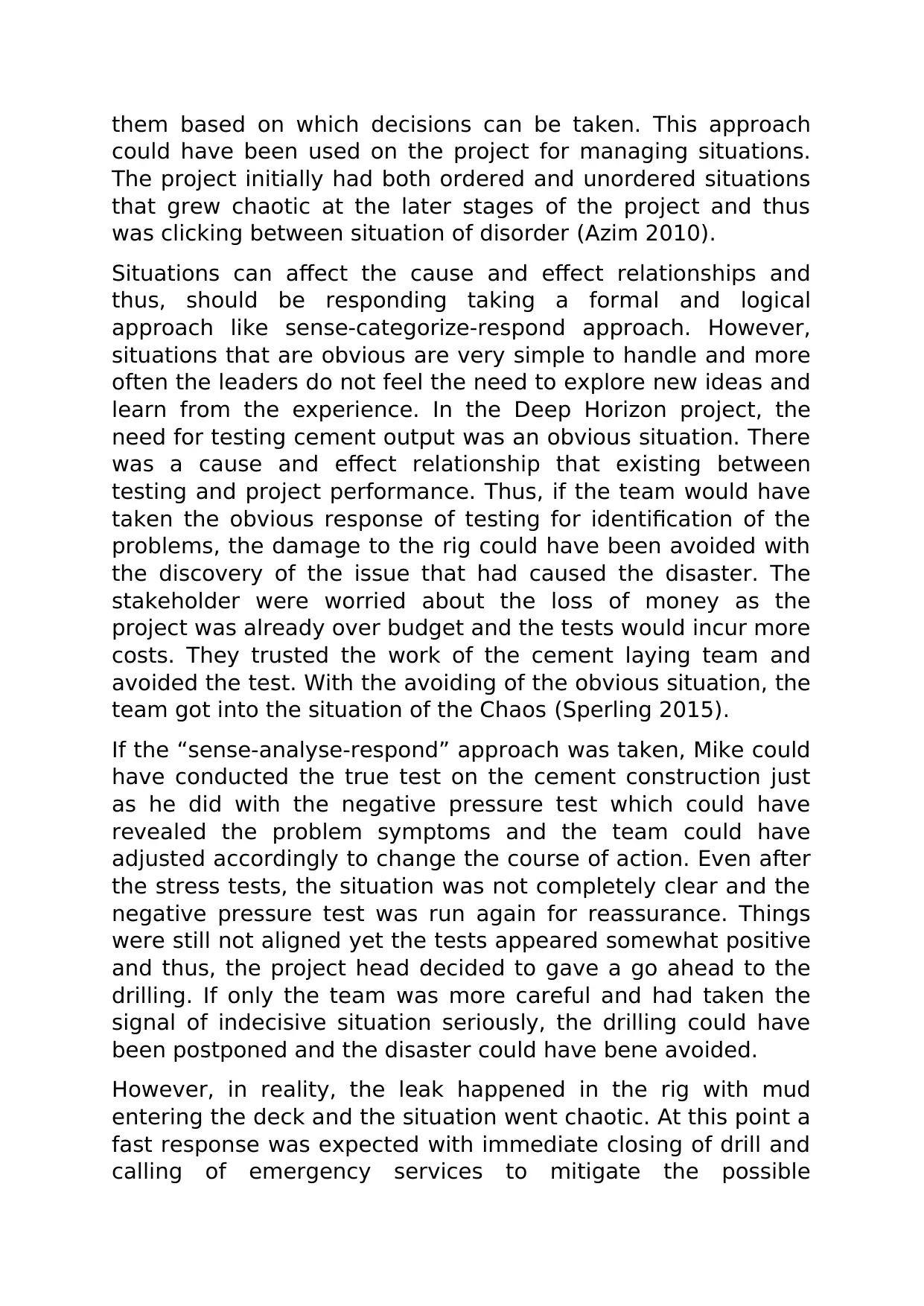
them based on which decisions can be taken. This approach
could have been used on the project for managing situations.
The project initially had both ordered and unordered situations
that grew chaotic at the later stages of the project and thus
was clicking between situation of disorder (Azim 2010).
Situations can affect the cause and effect relationships and
thus, should be responding taking a formal and logical
approach like sense-categorize-respond approach. However,
situations that are obvious are very simple to handle and more
often the leaders do not feel the need to explore new ideas and
learn from the experience. In the Deep Horizon project, the
need for testing cement output was an obvious situation. There
was a cause and effect relationship that existing between
testing and project performance. Thus, if the team would have
taken the obvious response of testing for identification of the
problems, the damage to the rig could have been avoided with
the discovery of the issue that had caused the disaster. The
stakeholder were worried about the loss of money as the
project was already over budget and the tests would incur more
costs. They trusted the work of the cement laying team and
avoided the test. With the avoiding of the obvious situation, the
team got into the situation of the Chaos (Sperling 2015).
If the “sense-analyse-respond” approach was taken, Mike could
have conducted the true test on the cement construction just
as he did with the negative pressure test which could have
revealed the problem symptoms and the team could have
adjusted accordingly to change the course of action. Even after
the stress tests, the situation was not completely clear and the
negative pressure test was run again for reassurance. Things
were still not aligned yet the tests appeared somewhat positive
and thus, the project head decided to gave a go ahead to the
drilling. If only the team was more careful and had taken the
signal of indecisive situation seriously, the drilling could have
been postponed and the disaster could have bene avoided.
However, in reality, the leak happened in the rig with mud
entering the deck and the situation went chaotic. At this point a
fast response was expected with immediate closing of drill and
calling of emergency services to mitigate the possible
could have been used on the project for managing situations.
The project initially had both ordered and unordered situations
that grew chaotic at the later stages of the project and thus
was clicking between situation of disorder (Azim 2010).
Situations can affect the cause and effect relationships and
thus, should be responding taking a formal and logical
approach like sense-categorize-respond approach. However,
situations that are obvious are very simple to handle and more
often the leaders do not feel the need to explore new ideas and
learn from the experience. In the Deep Horizon project, the
need for testing cement output was an obvious situation. There
was a cause and effect relationship that existing between
testing and project performance. Thus, if the team would have
taken the obvious response of testing for identification of the
problems, the damage to the rig could have been avoided with
the discovery of the issue that had caused the disaster. The
stakeholder were worried about the loss of money as the
project was already over budget and the tests would incur more
costs. They trusted the work of the cement laying team and
avoided the test. With the avoiding of the obvious situation, the
team got into the situation of the Chaos (Sperling 2015).
If the “sense-analyse-respond” approach was taken, Mike could
have conducted the true test on the cement construction just
as he did with the negative pressure test which could have
revealed the problem symptoms and the team could have
adjusted accordingly to change the course of action. Even after
the stress tests, the situation was not completely clear and the
negative pressure test was run again for reassurance. Things
were still not aligned yet the tests appeared somewhat positive
and thus, the project head decided to gave a go ahead to the
drilling. If only the team was more careful and had taken the
signal of indecisive situation seriously, the drilling could have
been postponed and the disaster could have bene avoided.
However, in reality, the leak happened in the rig with mud
entering the deck and the situation went chaotic. At this point a
fast response was expected with immediate closing of drill and
calling of emergency services to mitigate the possible
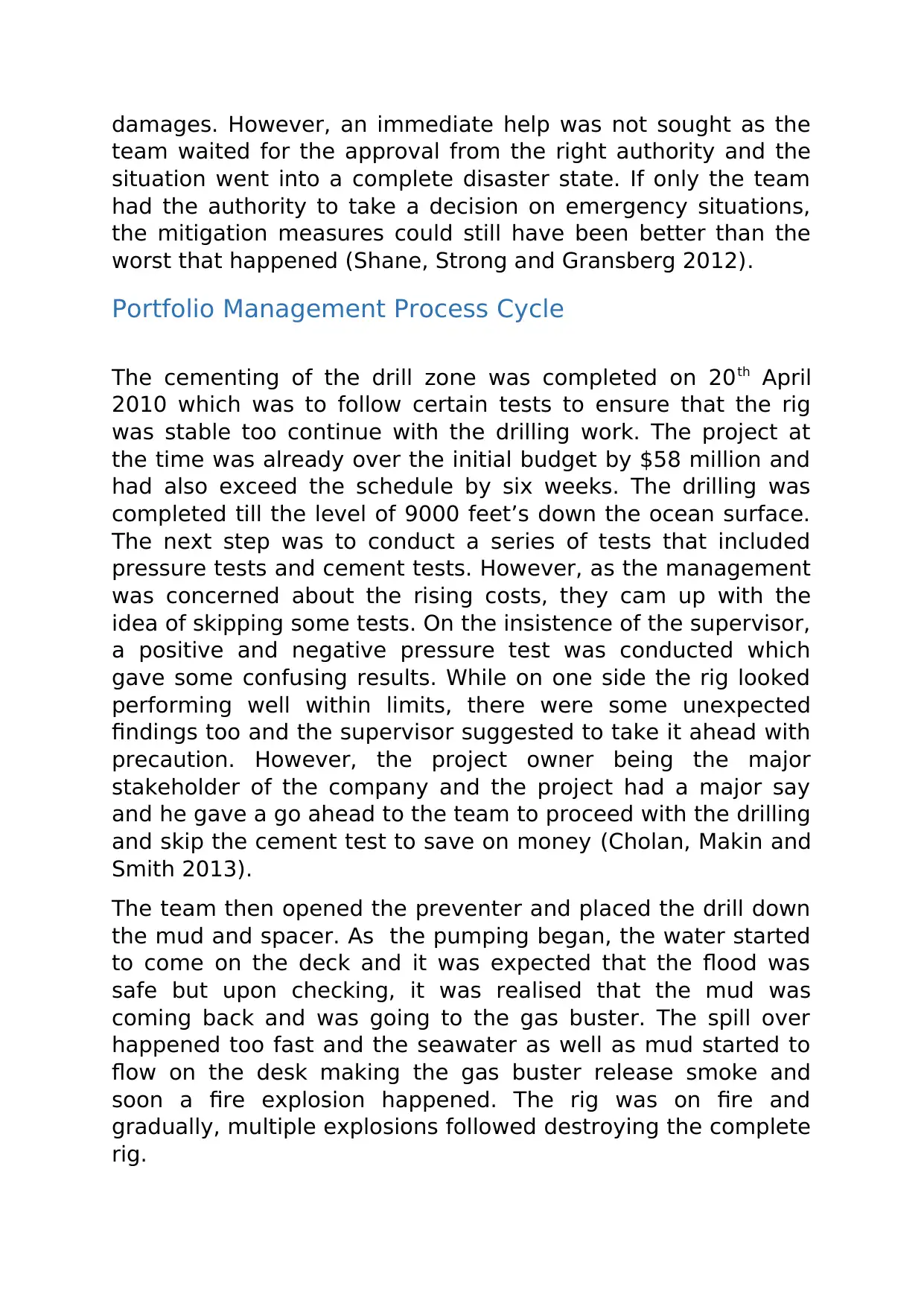
damages. However, an immediate help was not sought as the
team waited for the approval from the right authority and the
situation went into a complete disaster state. If only the team
had the authority to take a decision on emergency situations,
the mitigation measures could still have been better than the
worst that happened (Shane, Strong and Gransberg 2012).
Portfolio Management Process Cycle
The cementing of the drill zone was completed on 20th April
2010 which was to follow certain tests to ensure that the rig
was stable too continue with the drilling work. The project at
the time was already over the initial budget by $58 million and
had also exceed the schedule by six weeks. The drilling was
completed till the level of 9000 feet’s down the ocean surface.
The next step was to conduct a series of tests that included
pressure tests and cement tests. However, as the management
was concerned about the rising costs, they cam up with the
idea of skipping some tests. On the insistence of the supervisor,
a positive and negative pressure test was conducted which
gave some confusing results. While on one side the rig looked
performing well within limits, there were some unexpected
findings too and the supervisor suggested to take it ahead with
precaution. However, the project owner being the major
stakeholder of the company and the project had a major say
and he gave a go ahead to the team to proceed with the drilling
and skip the cement test to save on money (Cholan, Makin and
Smith 2013).
The team then opened the preventer and placed the drill down
the mud and spacer. As the pumping began, the water started
to come on the deck and it was expected that the flood was
safe but upon checking, it was realised that the mud was
coming back and was going to the gas buster. The spill over
happened too fast and the seawater as well as mud started to
flow on the desk making the gas buster release smoke and
soon a fire explosion happened. The rig was on fire and
gradually, multiple explosions followed destroying the complete
rig.
team waited for the approval from the right authority and the
situation went into a complete disaster state. If only the team
had the authority to take a decision on emergency situations,
the mitigation measures could still have been better than the
worst that happened (Shane, Strong and Gransberg 2012).
Portfolio Management Process Cycle
The cementing of the drill zone was completed on 20th April
2010 which was to follow certain tests to ensure that the rig
was stable too continue with the drilling work. The project at
the time was already over the initial budget by $58 million and
had also exceed the schedule by six weeks. The drilling was
completed till the level of 9000 feet’s down the ocean surface.
The next step was to conduct a series of tests that included
pressure tests and cement tests. However, as the management
was concerned about the rising costs, they cam up with the
idea of skipping some tests. On the insistence of the supervisor,
a positive and negative pressure test was conducted which
gave some confusing results. While on one side the rig looked
performing well within limits, there were some unexpected
findings too and the supervisor suggested to take it ahead with
precaution. However, the project owner being the major
stakeholder of the company and the project had a major say
and he gave a go ahead to the team to proceed with the drilling
and skip the cement test to save on money (Cholan, Makin and
Smith 2013).
The team then opened the preventer and placed the drill down
the mud and spacer. As the pumping began, the water started
to come on the deck and it was expected that the flood was
safe but upon checking, it was realised that the mud was
coming back and was going to the gas buster. The spill over
happened too fast and the seawater as well as mud started to
flow on the desk making the gas buster release smoke and
soon a fire explosion happened. The rig was on fire and
gradually, multiple explosions followed destroying the complete
rig.

After completion of the pressure tests, blow out preventer was
opened and the tram began to pump the seawater down the
drill to displace mud and spacer from the riser. The drilling was
stopped when spacer arrived on the rig for testing if the fluid
was safe to dump but in the process, a team member found out
that the drill was getting the mud back and it was getting
diverted to the gas buster. Both mud and seawater started to
blow on the deck as a result and soon gassy smoke filled it up.
It was followed by a series of fire explosions and the whole rig
was on fire.
Organizational Maturity
The level of maturity of the organization and the project can be
decided by the head managing the project outcome and taking
major decisions. The company needs to have proper
management and influence of the stakeholders. The
stakeholders of the project included the company head,
technicians, and drilling workers. The owner had a very high
influence on the project and thus, had to agree to by the
workers. The organization was not mature enough for the
workers to take decisions in critical events. Despite many
workers not satisfied with the idea of skipping some tests, the
same was done because of the influence from the top
management and the project was proceeded with.
Conclusions
The paper explored the case of Deep Water Horizon project
which proved out to be a complete failure because of certain
tests that were skipped. It was found that the result was
actually cause by the project management factors such as lack
of appropriate stakeholder management practices, lack of the
right skills and mind-sets in the major stakeholders.
References
Azim, S. W. (2010). Understanding and Managing Project Complexity . School of Mechanical,
Aerospace and Civil Engineering .
Bryant, J. (2014). Strategies for Managing Complex Projects. SHRP.
opened and the tram began to pump the seawater down the
drill to displace mud and spacer from the riser. The drilling was
stopped when spacer arrived on the rig for testing if the fluid
was safe to dump but in the process, a team member found out
that the drill was getting the mud back and it was getting
diverted to the gas buster. Both mud and seawater started to
blow on the deck as a result and soon gassy smoke filled it up.
It was followed by a series of fire explosions and the whole rig
was on fire.
Organizational Maturity
The level of maturity of the organization and the project can be
decided by the head managing the project outcome and taking
major decisions. The company needs to have proper
management and influence of the stakeholders. The
stakeholders of the project included the company head,
technicians, and drilling workers. The owner had a very high
influence on the project and thus, had to agree to by the
workers. The organization was not mature enough for the
workers to take decisions in critical events. Despite many
workers not satisfied with the idea of skipping some tests, the
same was done because of the influence from the top
management and the project was proceeded with.
Conclusions
The paper explored the case of Deep Water Horizon project
which proved out to be a complete failure because of certain
tests that were skipped. It was found that the result was
actually cause by the project management factors such as lack
of appropriate stakeholder management practices, lack of the
right skills and mind-sets in the major stakeholders.
References
Azim, S. W. (2010). Understanding and Managing Project Complexity . School of Mechanical,
Aerospace and Civil Engineering .
Bryant, J. (2014). Strategies for Managing Complex Projects. SHRP.
Paraphrase This Document
Need a fresh take? Get an instant paraphrase of this document with our AI Paraphraser
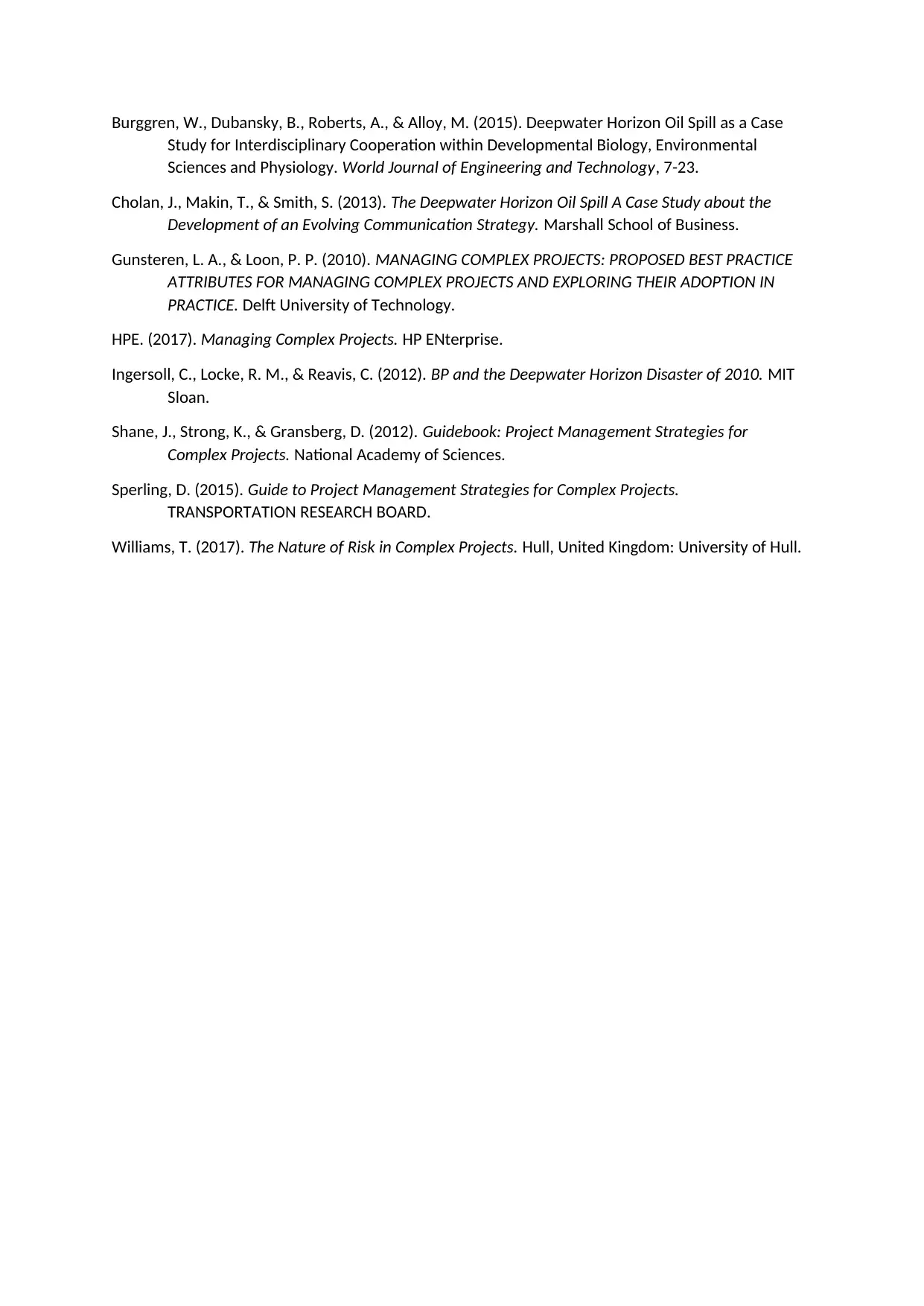
Burggren, W., Dubansky, B., Roberts, A., & Alloy, M. (2015). Deepwater Horizon Oil Spill as a Case
Study for Interdisciplinary Cooperation within Developmental Biology, Environmental
Sciences and Physiology. World Journal of Engineering and Technology, 7-23.
Cholan, J., Makin, T., & Smith, S. (2013). The Deepwater Horizon Oil Spill A Case Study about the
Development of an Evolving Communication Strategy. Marshall School of Business.
Gunsteren, L. A., & Loon, P. P. (2010). MANAGING COMPLEX PROJECTS: PROPOSED BEST PRACTICE
ATTRIBUTES FOR MANAGING COMPLEX PROJECTS AND EXPLORING THEIR ADOPTION IN
PRACTICE. Delft University of Technology.
HPE. (2017). Managing Complex Projects. HP ENterprise.
Ingersoll, C., Locke, R. M., & Reavis, C. (2012). BP and the Deepwater Horizon Disaster of 2010. MIT
Sloan.
Shane, J., Strong, K., & Gransberg, D. (2012). Guidebook: Project Management Strategies for
Complex Projects. National Academy of Sciences.
Sperling, D. (2015). Guide to Project Management Strategies for Complex Projects.
TRANSPORTATION RESEARCH BOARD.
Williams, T. (2017). The Nature of Risk in Complex Projects. Hull, United Kingdom: University of Hull.
Study for Interdisciplinary Cooperation within Developmental Biology, Environmental
Sciences and Physiology. World Journal of Engineering and Technology, 7-23.
Cholan, J., Makin, T., & Smith, S. (2013). The Deepwater Horizon Oil Spill A Case Study about the
Development of an Evolving Communication Strategy. Marshall School of Business.
Gunsteren, L. A., & Loon, P. P. (2010). MANAGING COMPLEX PROJECTS: PROPOSED BEST PRACTICE
ATTRIBUTES FOR MANAGING COMPLEX PROJECTS AND EXPLORING THEIR ADOPTION IN
PRACTICE. Delft University of Technology.
HPE. (2017). Managing Complex Projects. HP ENterprise.
Ingersoll, C., Locke, R. M., & Reavis, C. (2012). BP and the Deepwater Horizon Disaster of 2010. MIT
Sloan.
Shane, J., Strong, K., & Gransberg, D. (2012). Guidebook: Project Management Strategies for
Complex Projects. National Academy of Sciences.
Sperling, D. (2015). Guide to Project Management Strategies for Complex Projects.
TRANSPORTATION RESEARCH BOARD.
Williams, T. (2017). The Nature of Risk in Complex Projects. Hull, United Kingdom: University of Hull.
1 out of 8
Related Documents
Your All-in-One AI-Powered Toolkit for Academic Success.
+13062052269
info@desklib.com
Available 24*7 on WhatsApp / Email
![[object Object]](/_next/static/media/star-bottom.7253800d.svg)
Unlock your academic potential
© 2024 | Zucol Services PVT LTD | All rights reserved.




